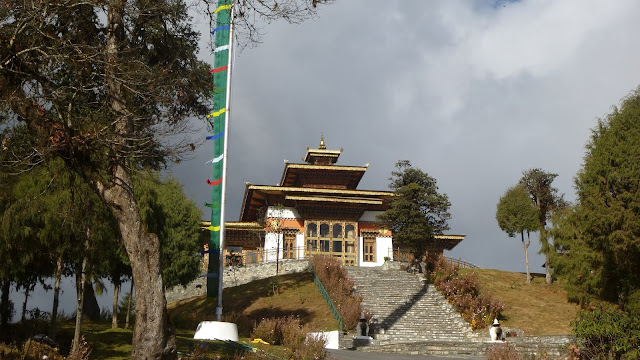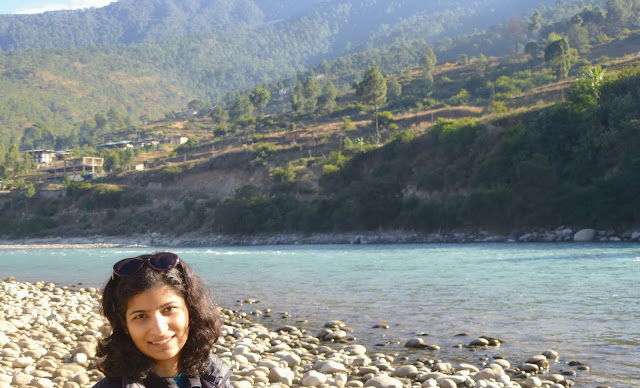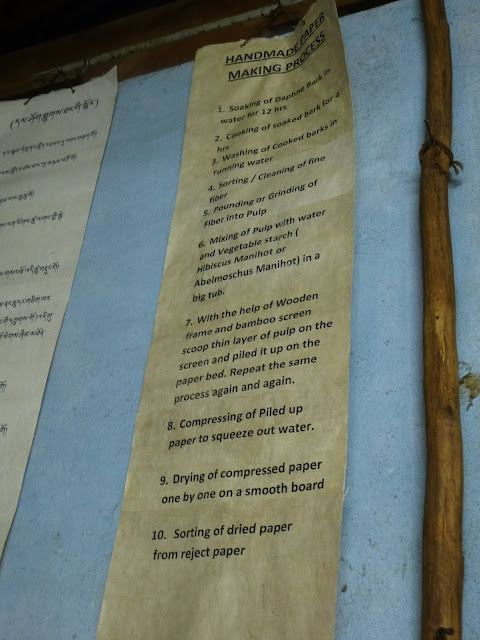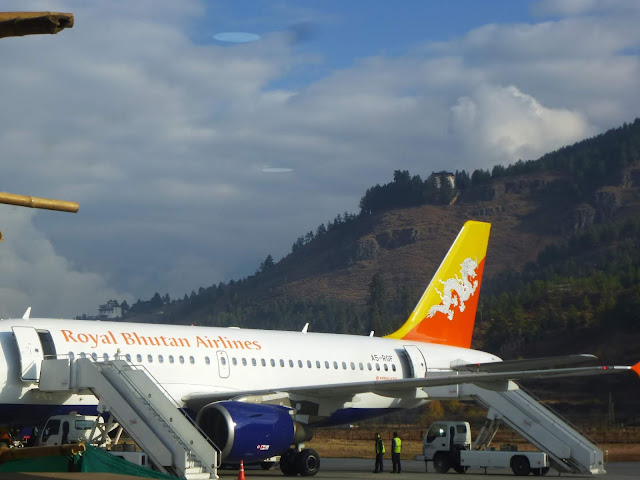Nov 27 - Dec 2, 2016
This is a retrospective post. I wrote this everyday during my trip whenever I got time. Found this in my laptop and posting it here so that it doesn't get lost. I want to add a brief note on how this trip got planned. It wasn't a lot of planning as such. I am not sure how the thought of Bhutan came to my mind. I think it was after I decided that I wanted to take a small vacation before, after or within my India vacation. The main criteria was to look for a place where I don't have to do much planning. Bhutan fit well in it as Indians don't need a visa and I got references for it through my work travel group. All planning was done over emails with Dorji Gyeltshen from Smile Bhutan. A number of Googlers had toured Bhutan with him so I blindly trusted him and the trip was indeed very well organized.
Day 1:
We started from Delhi and landed at the Paro airport around 2:30pm. This is a unique landing. The plane took couple of turns to get into the valley avoiding touching the mountains and the homes nearby and landed in the backyard of the airport building which did not look like a usual airport. It was as if the plane landed in the backyard of the house. Immigration was very quick and then we met our tour guide for the next 5 days - Dorji and the driver Shiring. He greeted us in a traditional way with a bhutanese white silk scarf.



We then headed towards Thimphu. We stopped in between to see the point where River Paro and Thimphu meet. We also saw the 3 different types of stupas in Bhutan - Nepalese, Tibet and bhutanese style.


We then headed straight to Thimphu. During our drive talked with the guide about Bhutan and its history etc. After reaching Thimphu, we checked into the Hotel - hotel Taktsang. Not a super luxurious hotel but had basics. We then ordered our dinner to be had later and headed towards the Chorten Lam - a memorial built for a king. There was a special 10 day prayer going on - usually organized by monasteries. There were mantra cylinders which have thousands of mantras written covered with a metal cylinder which also has mantras carved on it. We rotated the mantra cylinders as they say if you rotate it once, you basically chanted the thousands of mantras written inside the metal cylinder.


After taking a round of the memorial we saw that a monk was giving ‘holy water’ (charanaamrat) to people, we obviously got there to get some holy water with blessings. Our guide was telling us about the holy water and in return we became his guide and told him about our Indian culture and our holy water (charanaamrat). He mentioned that buddhism in Bhutan and hinduism have a lot of common gods - Ganesha, Shiva to name a few (can’t remember the bhutanese names of them).

We then headed towards the main Thimphu market - Norzin Lam. Its just a street. It felt a lot like the Bhutani market on the Nainital flats but just on one straight street. Interestingly Thimphu has only one traffic signal (I didn’t find the signal but there was a square with a traffic police) of Bhutan. Bhutan apparently has no traffic lights!


After getting back to the hotel we had some masala chai and then took some rest in the room before dinner and also planned for the next day to see what we can suggest more to our guide.


Day 2:
Today we are going to Punakha Valley. After having breakfast at the hotel, we headed towards Punakha at around 8:30am. Our first stop was Dochula pass. We saw the monastery there which was created when Bhutan decided to fight with Bodo and Ulfa militants. Weather was great but we could not see the himalayan range due to clouds. We also saw the 108 stupas on the other side of the road. It was beautiful.




We then headed straight to Punakha valley. After reaching Punakha, our first spot was Chimi Lhakhang, a buddhist monastery dedicated to Drukpa Keenly the divine madman. We took a short 30 min hike to the temple. It is also known as the temple of fertility and people come here with a wish for child. Our guide had got pictures of 2 couples from taiwan as they wanted to get the blessings for a child. Monk in the monastery gave the blessings to the pictures. Our guide told us the story about the madman and how the temple was made. Apparently the madman monk was famous for his aggressive lifestyle where he would drink and keep company of women. There is a stupa in the temple which signifies madman subduing a demon. His half brother later built the temple.



After the temple we had lunch at the chimi lhakhang cafe. We finally tasted the ema datshi (chilli cheese). It was only worth tasting.


After lunch we went to see the Punakha Dzong. On the way we also took a walk on the suspension bridge which connects parts of Punakha. Punakha Dzong (fort) is huge and has a monastery/temple along with government offices. As per our guide one of the monk died and later his body shrunk and started emitting incense and is still kept in one of the buildings. Visitors are not allowed entry in that building.


After visiting dzong we headed for another hike to the Khamsum Yulley Namgyal Chorten (temple). The hike was great and with a bit of elevation. We walked along the farms of locals. Crops had already been harvested so there wasn’t any greenery in the farms but the views were still great. In-between we had to give way to the donkeys of the farmers which they use to carry heavy stuff to their homes. This temple was built for the current king by the queen mother as suggested by the astrologer for the wellness of Bhutan. This temple is for the energy buddha - the terrifying form of buddha. The views of the valley from the temple top were amazing. After a quick look at the temple deities, we hiked down back. From there we headed straight to the hotel - demchen resort.







We had dinner at a bhutanese restaurant today. Food was mostly bhutanese - rice, lentil soup, butter tea, momos, dry vegetable and a special dish which was cheese and ghee. Apparently that is only made when special guests come.


Day 3:
Today we started at 9am from the hotel after the breakfast. We headed back towards Thimphu. In between we stopped at Dochula pass to take pictures of the himalayan mountain range. We had tea and biscuits sitting outside with a view of the himalayas and the 108 stupas on the other side of the road. Majestic views and somewhat similar to the hills of Uttarakhand in India. After this we went straight to Thimphu. In between we saw monks convoy which was heading from Thimphu to Punakha for the winter as Punakha is less cold than Thimphu. Punakha is the winter capital for monks where they will stay till April now. Bhutanese locals were standing in a line by the side of the road waiting for the monks convoy to get the blessings from the head of the monks.




After reaching Thimphu, we first stopped by the Takin (national animal of Bhutan) reserve to see the Takin. It looks like a goat from the head and an ox with the body and claws. As per the folklore, Takin was created by the buddha that brought buddhism in bhutan.

After seeing Takins, we came to the hotel for checkin and lunch. We started again at 1:45pm to visit the National folk history museum. The museum shows a typical house in a bhutanese village. It was a lot similar with our old houses in the uttarakhand village. There were multiple storeys with each having its own use - ground floor for cattle, first floor for food and grain storage and second floor for kitchen and sleeping room.

From here we went to see the national library. This library has a lot of scriptures.



While returning from the library we saw Bhutan's royal buildings where the king resides.

From there we went to see the tallest buddha statue on top the mountain. This was 182ft statue of buddha. Inside were lovely. The views from outside gave a good view of the Thimphu town.


Day 4:
Today we started at 8:30am after breakfast from hotel for the tango monastery which was 9-10 km from Thimphu. The drive was very beautiful as we got out of the city. Once we reached the monastery which was in between the pine trees, we immediately started hiking up the paved path to reach the temple. It took us 45 min to reach up. Views from the hike were awesome as it was early morning and we were on a higher elevation. There was one another group hiking at the same time.





Once we reached the temple out guide told us the story of one of the paintings where one of the person who committed gross crime in his life was able to achieve enlightenment in the same life. The temple inside had a special small temple of past, present and future buddha and it's said that if you ask for something there you get it. We sat inside the main temple hall for some time. There was a family also sitting and chanting mantras in dzongkha. We then went to see another temple at the back which also had a community hall where some monks were studying buddhist books. This monastery was founded long back by someone who has reincarnated again. A small boy of 7 yrs who had founded this monastery in his previous life went to the king and asked him about why he shaved off his beard (apparently they knew each other in previous life). Today this boy who is now around 10-15 yrs is the chief abbot of this monastery and his picture was placed at the seat of chief Abbot as is usually the case in all temples. It was hard to believe but then seeing that boy's picture there and in one other major monastery (taktsang) it felt like reincarnation is a reasonable belief. There was one other temple with a rock with head of the horse but we skipped that. I guess we didn't want to climb more stairs. Our guide told that all main saints who meditated here long back at this monastery saw the head of the horse in their mind so this temple has got significance here.





We then came down and headed towards the town to have lunch. We had lunch at a hotel in the main town area. We ordered hot and sour soup which turned out to be a disaster. After few sips of the hot soup we gave up. The rest of the food - fulka, daal and aloo jeera was good. After lunch we strolled in the market before heading to the craft school which was unfortunately closed . We then visited textile museum and saw textiles of bhutan. They still wear clothes (gho and kira) weaved locally. After the museum we went to the handmade paper factory which makes paper from the bark of a tree. It was awesome to see how the tree bark can transform into something so nice. The souvenirs made of paper were quite expensive so we skipped buying. The lampshade was quite nice.

After that we went to the craft bazaar. It was a long street of shops owned by locals which were selling handmade crafts. We bought a thangka with the 8 auspicious symbols of bhutan. I also liked the handmade bags made out of wool. This was end of day 4.

Day 5:
Looks like I did not write about this day in my trip diary 2 year back. I think its clear why as the experience itself was so great that I took the time to soak into it later in the day as well. This was our last day in the trip before we head back to India. It was an important day as we were about to visit the Tigers Nest or the Taktsang Monastery near Paro. It's very famous and such a mesmerizing hike. I enjoyed the hike even though it wasn't easy. I really enjoyed all the views along the hike and the excitement of seeing the hanging monastery from far. That night we just relaxed as the hike was intense. We stayed in Paro that night and took a flight back to Delhi next morning.







I must thank my brother for constantly nagging me to write my trip experience in a blog.
Royal Bhutan Airlines plane that we took. It was a great flight with wonderful views of Himalayas. The airline provided us great food onboard. This was one flight where everyone wanted a window seat!

Until next time....







